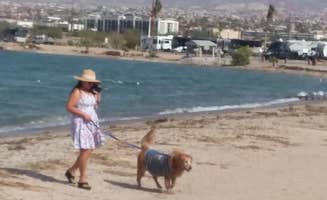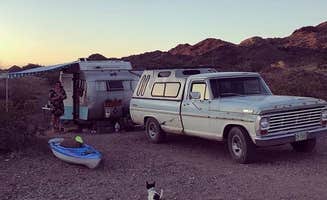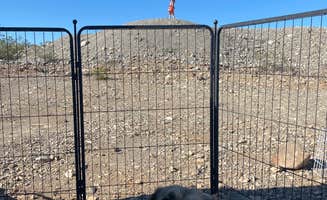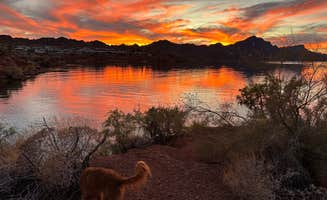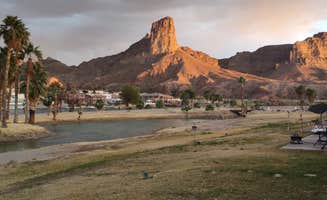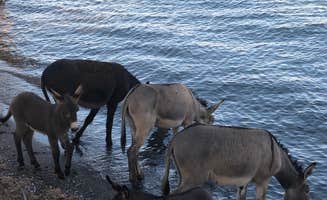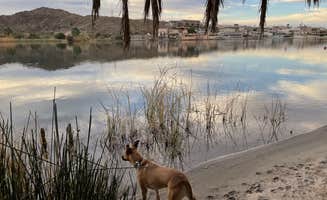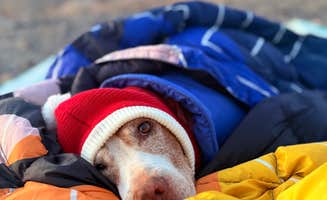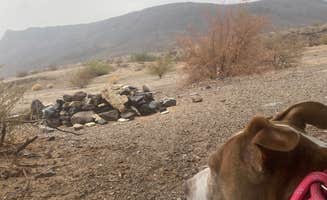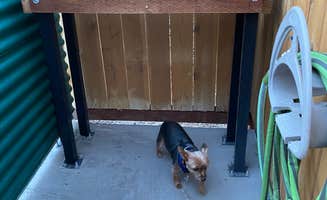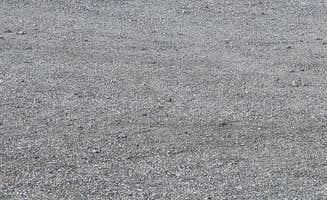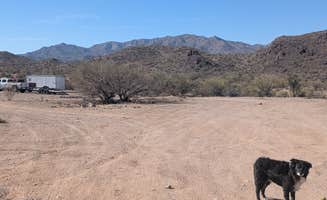Dispersed camping areas near Lake Havasu City, Arizona sit at approximately 600 feet elevation and experience intense summer heat with temperatures regularly exceeding 110°F. The terrain consists primarily of hard-packed desert soil with scattered creosote bushes and sparse desert vegetation. Winter temperatures drop to 40-60°F daytime, making it popular for seasonal campers from November through March.
What to do
Desert hiking trails: The area near Craggy Wash Dispersed Camping offers unique rock formations for exploration. "Cool spot to fly the drone, caves and weird stuff left behind by previous campers," reports David H. The wash area provides natural protection from winds while offering terrain suitable for short day hikes.
Waterfront activities: Camp within walking distance of Colorado River access at Beachcomber Resort. According to Alicia F., "If you're coming to Lake Havasu odds are that you'll have a boat with you and this is one of the best places to stay." The resort provides boat slips, launch facilities, and shoreline access for swimming.
Wildlife observation: Watch for desert wildlife including wild burros near campgrounds on the California side of the lake. "It was interesting sighting wild donkeys," notes aneeqa at Havasu Landing Resort Campground. Early morning and evening hours provide the best opportunities for wildlife viewing when temperatures are cooler.
What campers like
Scenic lake views: The western shore offers dramatic sunset vistas over Lake Havasu. "This park gets some stunning sunsets first of all!!! make sure you wear your shades so you can enjoy it to the fullest," writes Brittney C. about Beachcomber Resort. Most waterfront sites require advance reservations during peak season.
Proximity to urban amenities: Havasu BLM Dispersed camping provides free accommodation with convenient access to town services. Chris M. notes it's "Only minutes from Lake Havasu City. Lots of room to find a semi level spot." The area allows campers to access grocery stores and restaurants while maintaining budget-friendly camping options.
Winter climate: The moderate winter temperatures attract seasonal visitors. Linda M. comments about Havasu BLM: "Been here often and love the spot especially for big rigs. Close enough to go to beach, groceries, activities." November through March typically provides comfortable 60-75°F daytime temperatures with minimal rainfall.
What you should know
Heat management considerations: Summer temperatures frequently exceed 110°F, requiring careful planning. "It was just under 90°F at midnight and the ground was so rocky that sleeping was a challenge," reports Kirsten C. about Lone Tree Dispersed Camping BLM. Shaded camping locations become critical during summer months.
Water conservation needs: No potable water exists at dispersed sites. Greg L. notes about Lone Tree: "No water, no trash dumpsters, no toilets, no designated sites." Campers must bring sufficient water for drinking, cooking, and pet hydration - plan for 1-2 gallons per person per day.
Waste disposal requirements: Dispersed camping areas lack trash services. "Lots of trash, and it has been here for some time. The trash attracts bugs, so the fly situation is higher than some other places," David H. observes about Craggy Wash. Pack-out policies require transporting all waste to authorized disposal facilities in Lake Havasu City.
Tips for camping with families
Campground facilities: Crazy Horse Campgrounds offers family-oriented amenities including swimming areas. Clint J. shares, "It was a little pricey but it was last min and we were chasing the sun... so we just did it. It was so nice sitting by the lake and enjoying the beautiful evening." The campground provides shoreline access with gradual entry points suitable for younger children.
Activity planning: Schedule water activities during morning hours when winds are typically calmer. "Waking up to the sound of the water on the shoreline was so peaceful!" notes Clint J. about Crazy Horse Campgrounds. Afternoon temperatures often make outdoor activities uncomfortable during summer months.
Site selection strategy: Choose locations away from main traffic routes. Jeffrey F. mentions about Craggy Wash: "Took me another mile to find a place that was away from people. The spot was beautiful, but fair amount of trash and dog crap." Sites farther from main entrance roads typically offer quieter camping experiences.
Tips from RVers
Leveling considerations: Bring leveling blocks for uneven terrain at dispersed sites. Chris M. notes about Havasu BLM: "Lots of room to find a semi level spot. You can park far enough off the highway no highway noise. Lots of big rigs. No issue for 40' pusher and 24' car hauler." Most dispersed areas feature natural terrain without graded camping pads.
Cell service variability: Signal strength varies significantly across camping areas. Greg L. mentions about Craggy Wash: "Cell signal is dependent on where you camp, have to have line of sight to the cell tower across hwy 95, otherwise no cell signal." Higher elevation camping spots typically provide better connectivity.
Road condition awareness: Havasu Falls RV Resort offers well-maintained access roads for larger vehicles. Brittney C. reports it has "Brand new paved roads" and "nice paved pull through sites." Many dispersed camping areas require navigating unpaved washboard roads with occasional rocky sections that challenge lower-clearance RVs.


